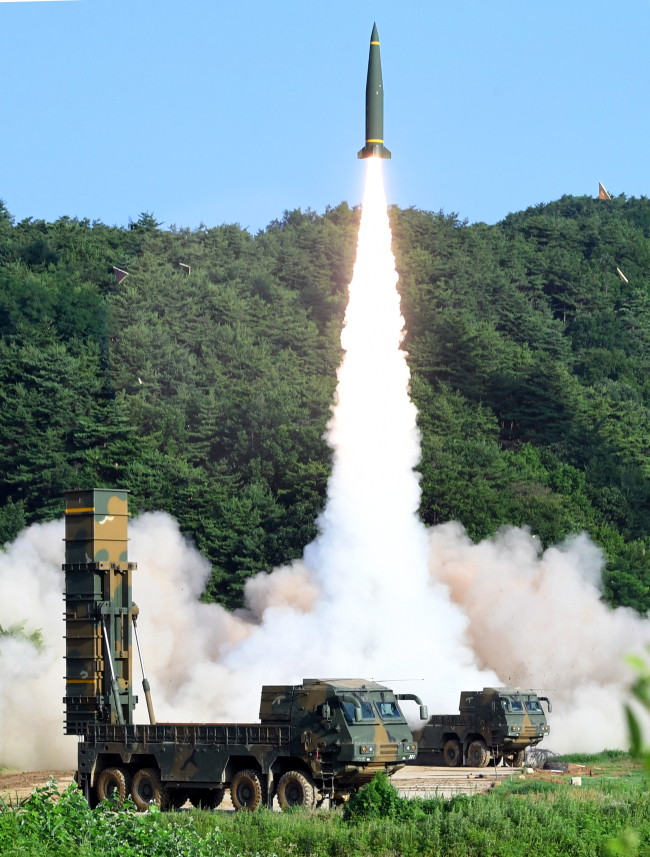Seoul’s push for stronger missiles could irk China again: experts
By Sohn Ji-youngPublished : July 25, 2017 - 18:12
South Korea’s push for stronger ballistic missiles may boost its deterrence capability against North Korea, but it would require a renegotiation of a military pact with the US and may prompt opposition from China, experts said Tuesday.
In his first summit with US President Donald Trump last month, President Moon Jae-in floated the idea that the bilateral missile guideline pact be revised so that Seoul can double the maximum payload of its ballistic missile warheads from the current 500 kilograms, according to government sources.
The offer was met with a positive response from Trump and is likely to be discussed during the allies’ annual high-profile security meetings later this year, such as the Security Consultative Meeting and the Korea-US Integrated Defense Dialogue, the sources added.
But renegotiating the bilateral agreement would be an uphill battle, analysts noted, as it could provoke strong opposition from neighboring countries, in particular China, which may see South Korea’s enhanced missile capability as a security threat.

“(The revision on missile warheads) would allow South Korea to possess destructive retaliation capability against North Korea’s potential nuclear attacks,” said Kim Dong-yup, a military expert and professor at Kyungnam University’s Far East Institute.
“But the increased weight would lead to extending the missiles’ range, which is likely to make neighboring countries, such as China, feel worried. I think the government is in a difficult position because the plan was revealed to the public before the government builds its case.”
The presidential office Cheong Wa Dae on Tuesday remained mum about whether it would pursue a revision to the pact. It also refused to comment on whether the issue would be discussed during the allies’ security meetings.
Under the current agreement with the US, sealed in 2012, South Korea is banned from mounting more than 500-kilogram warheads onto 800-kilometer range ballistic missiles that can reach almost every part of North Korea.
The clause has remained a constraint on South Korea’ capability to take out North Korea’s nuclear facilities and its wartime command, as 500-kilogram warheads are thought not to be strong enough to destroy facilities hidden in deep mountain caves or underground.
“With a 1-ton warhead, we will make remarkable progress in our ability to strike North Korea’s leadership,” said Jang Young-geun, a missile expert and professor of aerospace and mechanic engineering at Korea Aerospace University.
But revising the agreement would prompt opposition from neighboring countries, analysts warned, suggesting that if the allies were to agree on a new deal, South Korea could develop extended range ballistic missiles capable of reaching China and Russia.
Under the 2012 guideline’s “trade-off” principle, South Korea can increase the range of the missile proportionately should the range decrease, meaning that it could develop a 1,600-kilometer range ballistic missile with a 500-kilogram warhead.
When South Korea deployed Terminal High Altitude Area Defense system batteries to fend off North Korea’s short-and-medium range missiles last year, China opposed the move, claiming that THAAD’s advanced radar could spy on its territories.
“If there were such discussions between South Korea and US leaders, the government should have kept it confidential until it finished its job,” said Rep. Kim Young-woo of the conservative Bareun Party, a chairman of the National Assembly’s defense committee.
By Yeo Jun-suk (jasonyeo@heraldcorp.com)


![[Exclusive] Korean military set to ban iPhones over 'security' concerns](http://res.heraldm.com/phpwas/restmb_idxmake.php?idx=644&simg=/content/image/2024/04/23/20240423050599_0.jpg&u=20240423183955)

![[Graphic News] 77% of young Koreans still financially dependent](http://res.heraldm.com/phpwas/restmb_idxmake.php?idx=644&simg=/content/image/2024/04/22/20240422050762_0.gif&u=)



![[Pressure points] Leggings in public: Fashion statement or social faux pas?](http://res.heraldm.com/phpwas/restmb_idxmake.php?idx=644&simg=/content/image/2024/04/23/20240423050669_0.jpg&u=)









